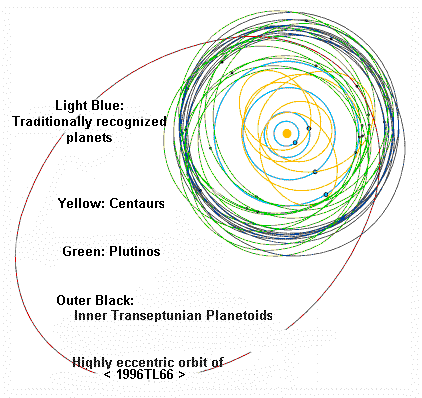The orbit of the new planet 1996TL66 is very strange: it reaches the vicinity of the outer planets every 800 years and makes a long loop far into outer space before reaching the Sun again

The solar system is larger than previously thought - it contains another planet, in the farthest orbit known so far. This is of course provided that the newly discovered body will indeed be declared a planet and not a large asteroid. Last week, astronomers reported the discovery of a tiny body about 500 km in diameter, orbiting the Sun far behind Pluto. Its enormous distance from the Sun, three times the distance of Pluto from it, is proof to researchers that the Sun's gravitational pull reaches much farther than they initially thought.
It is the brightest object discovered in the solar system beyond the orbit of Neptune. Its path is so far from Earth that it is very difficult to observe. According to Jane Lu, an astronomer, at the closest point to the telescope the object, named 1996TL66 for the time being, is at a distance of about 35 astronomical units (an astronomical unit is the distance between the Earth's orbit and the Sun - about 150 million km). At the far end of its orbit, it is up to 130 astronomical units away from it, that is, about 19.5 billion kilometers from the Sun, far beyond the orbits of Pluto and Neptune.
Theoretical calculations led the researchers to the conclusion that 1996TL66 is not alone - there are millions of such objects, composed mostly of ice, far beyond the outer planets. The astronomers believe that the new body belongs to the extended Kuiper belt - a belt of small objects that surrounds the Sun beyond the orbit of Neptune. About 40 such bodies have been discovered since 1992. Prior to that, the only objects identified in the Kuiper Belt were the planet Pluto discovered in 1930 and the Ark discovered in 1978.
Lu discovered 1996TL66 along with colleagues from Harvard, the University of Hawaii and the University of Arizona, and several amateur astronomers. The detailed description appeared in "Nature". "I wouldn't say it's a planet like the main planets of the solar system," says Brian Marceran, an astronomer at Harvard and co-author of the paper, "but with the same information I wouldn't say that about Pluto."
In fact, it has already been decided that 1996TL66 is too small to be named after a Roman god, like the other planets. Astronomers estimate that it is composed of the same substances as the other planets - water, carbon dioxide, methane - all in a frozen state.
1996TL66 was discovered by the University of Hawaii's Large Telescopes when it crossed the exoplanet region in October 96. Its orbit is very strange: it reaches the vicinity of the outer planets every 800 years and makes a long loop far out into outer space, before coming close to the Sun again. Astronomers have never seen anything like this: "This just proves how much we don't know exactly what the outer solar system is hiding inside," she tells him. But the truth is that there were already some researchers who predicted that such an object must exist. One of them is Hal Levison, a scientist at the Southwestern Research Institute in Boulder, Colorado, in a study he conducted together with Martin Dokman from Queen's University in Canada, the results of which should be published in one of the upcoming issues of Nature.
"Even though we knew we had an interesting scientific conclusion, I had no idea that anyone would be able to find such an object," Levison said. "The fact that someone confirmed my theory gives me deep satisfaction."
In his paper, Levison describes how Uranus and Neptune formed the Kuiper Belt during the formation of the Solar System, more than 4 billion years ago. According to this theory, Neptune deflected part of the Kuiper belt into strange orbits like 1996TL66.
Additional articles on the subject:
